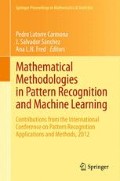Abstract
Conditional Random Fields (CRF) are popular methods for labeling unstructured or textual data. Like many machine learning approaches, these undirected graphical models assume the instances to be independently distributed. However, in real-world applications data is grouped in a natural way, e.g., by its creation context. The instances in each group often share additional structural consistencies. This paper proposes a domain-independent method for exploiting these consistencies by combining two CRFs in a stacked learning framework. We apply rule learning collectively on the predictions of an initial CRF for one context to acquire descriptions of its specific properties. Then, we utilize these descriptions as dynamic and high quality features in an additional (stacked) CRF. The presented approach is evaluated with a real-world dataset for the segmentation of references and achieves a significant reduction of the labeling error.
Access this chapter
Tax calculation will be finalised at checkout
Purchases are for personal use only
References
Arnold, A., Cohen, W.W.: Intra-document structural frequency features for semi-supervised domain adaptation. In: Proceeding of the 17th ACM Conference on Information and Knowledge Management, pp. 1291–1300. ACM, New York (2008)
Batal, I., Hauskrecht, M.: Constructing classification features using minimal predictive patterns. In: Proceedings of the 19th ACM International Conference on Information and Knowledge Management, pp. 869–878. CIKM ’10, ACM, New York (2010)
Bunescu, R., Mooney, R.J.: Collective information extraction with relational markov networks. In: Proceedings of the 42nd Annual Meeting on Association for Computational Linguistics. ACL ’04, Association for Computational Linguistics, Stroudsburg, PA (2004)
Cohen, W.W.: Fast effective rule induction. In: Proceedings of the Twelfth International Conference on Machine Learning, pp. 115–123. Morgan Kaufmann, Los Altos (1995)
Cortes, C., Vapnik, V.: Support-vector networks. Mach. Learn. 20(3), 273–297 (1995)
Councill, I., Giles, C.L., Kan, M.Y.: ParsCit: an open-source CRF reference string parsing package. In: Proceedings of the Sixth International Language Resources and Evaluation (LREC’08). ELRA, Marrakech, Morocco (2008)
Finkel, J.R., Grenager, T., Manning, C.: Incorporating non-local information into information extraction systems by gibbs sampling. In: Proceedings of the 43rd Annual Meeting on Association for Computational Linguistics, pp. 363–370. ACL ’05, Association for Computational Linguistics, Stroudsburg, PA (2005)
Gulhane, P., Rastogi, R., Sengamedu, S.H., Tengli, A.: Exploiting content redundancy for web information extraction. Proc. VLDB Endow. 3, 578–587 (2010)
Klösgen, W.: Explora: a multipattern and multistrategy discovery assistant. In: Fayyad, U., Piatetsky-Shapiro, G., Smyth, P., Uthurusamy, R. (eds.) Advances in Knowledge Discovery and Data Mining. Menlo Park, CA, USA, pp. 249–271. (1996)
Kou, Z., Cohen, W.W.: Stacked graphical models for efficient inference in markov random fields. In: Proceedings of the 2007 SIAM International Conference on Data Mining, SIAM, address of publisher is not known. probably. Minneapolis, Minnesota, USA (2007)
Krishnan, V., Manning, C.D.: An effective two-stage model for exploiting non-local dependencies in named entity recognition. In: Proceedings of the 21st International Conference on Computational Linguistics and the 44th Annual Meeting of the ACL, pp. 1121–1128. ACL-44, ACL, Stroudsburg, PA (2006)
Lafferty, J., McCallum, A., Pereira, F.: Conditional random fields: probabilistic models for segmenting and labeling sequence data. In: Proceedings of the 18th International Conference on Machine Learning, Morgan Kaufmann Publishers Inc., San Francisco, CA, USA, pp. 282–289 (2001)
McCallum, A.: Efficiently inducing features of conditional random fields. In: Nineteenth Conference on Uncertainty in Artificial Intelligence (UAI03), Morgan Kaufmann Publishers Inc., San Francisco, CA, USA (2003)
Peng, F., McCallum, A.: Accurate information extraction from research papers using conditional random fields. In: HLT-NAACL, Association for Computational Linguistics, Boston, Massachusetts, USA, pp. 329–336 (2004)
Richardson, M., Domingos, P.: Markov logic networks. Mach. Learn. 62(1–2), 107–136 (2006)
Sutton, C., McCallum, A.: Collective segmentation and labeling of distant entities in information extraction. In: ICML Workshop on Statistical Relational Learning and Its Connections to Other Fields (2004)
Wolpert, D.H.: Stacked generalization. Neural Networks 5, 241–259 (1992)
Yang, J.M., Cai, R., Wang, Y., Zhu, J., Zhang, L., Ma, W.Y.: Incorporating site-level knowledge to extract structured data from web forums. In: Proceedings of the 18th International Conference on World Wide Web, pp. 181–190. ACM, New York (2009)
Author information
Authors and Affiliations
Corresponding author
Editor information
Editors and Affiliations
Rights and permissions
Copyright information
© 2013 Springer Science+Business Media New York
About this paper
Cite this paper
Kluegl, P., Toepfer, M., Lemmerich, F., Hotho, A., Puppe, F. (2013). Exploiting Structural Consistencies with Stacked Conditional Random Fields. In: Latorre Carmona, P., Sánchez, J., Fred, A. (eds) Mathematical Methodologies in Pattern Recognition and Machine Learning. Springer Proceedings in Mathematics & Statistics, vol 30. Springer, New York, NY. https://doi.org/10.1007/978-1-4614-5076-4_8
Download citation
DOI: https://doi.org/10.1007/978-1-4614-5076-4_8
Published:
Publisher Name: Springer, New York, NY
Print ISBN: 978-1-4614-5075-7
Online ISBN: 978-1-4614-5076-4
eBook Packages: Mathematics and StatisticsMathematics and Statistics (R0)

